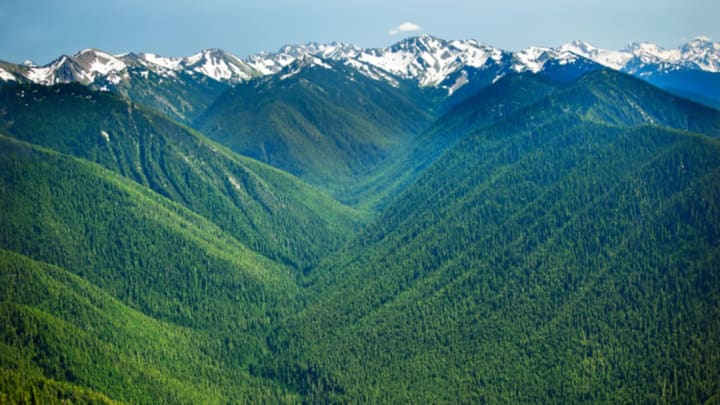15 Things You Might Not Know About Washington

1. Washington is the number one exporter of apples in the country—100 million boxes (each weighing 40 pounds) are harvested each year. The state's dry weather and cold winters make for the perfect growing environment.
2. The state is also responsible for producing the majority of the country’s hops and mint.
3. Spokane, Washington, is the smallest city to ever host a World’s Fair. The 1974 event, which marked the first time the World's Fair had an environmental theme, was attended by 5.6 million people and considered a success.
4. Washington is the floating bridge capital of the world. While floating (or pontoon) bridges have been in use since ancient China, Washington's first floating bridge was built over Lake Washington because the lake's bed was too soft and deep for support towers. Today, the state is home to four out of the five longest floating bridges; Governor Albert D. Rosellini Bridge, the longest, spans over 7,579 feet.
5. The Space Needle in Seattle was built for the 1962 World’s Fair. It was built in just 400 days, and at the time was the tallest structure west of the Mississippi.
6. Seatlle architect John Graham designed the country's first revolving restaurant: La Ronde, located at the Ala Moana Center in Honolulu, opened in 1961. Just a couple years later, Graham brought his design back to his home city. The Eye of the Needle (now called SkyCity), opened in the Space Needle in 1963. Inside, diners sit at tables in a 14-foot ring atop a 125-ton spinning platform that makes one complete revolution ever 47 minutes.
7. Harbor Island, located in the mouth of Seattle’s Duwamish Waterway, is the largest man-made island in the country. At 350 acres, it was the largest man-made island in the world at the time of its construction in 1909. Today, Rokko Island in Japan (1,433 acres) holds that distinction. In 1938, Harbor Island lost the title of largest man-made island in the U.S. to Treasure Island in San Francisco Bay, but it regained its glory after adding 47 acres in 1967.
8. Mount Rainier is still considered an active volcano. The stratovolcano has only erupted 12 times in the last 2,600 years, most recently in 1894.
9. Speaking of Mount Rainier, the term flying saucer was coined after a pilot saw mysterious circular objects by the volcano. The aviator ushered in the modern UFO era after describing them as saucer-like.
10. In 1889, a fire destroyed 25 blocks of downtown Seattle. Instead of rebuilding or relocating, the people of Seattle decided to just elevate and build right on top of the rubble. Today, visitors can take tours through the underground passageways.
11. The citizens of Washington take their cryptids very seriously; it’s a felony to harass Sasquatch or any other unknown subspecies in Whatcom County.
12. Over 50 different kinds of petrified trees reside in the Ginkgo Petrified Forest State Park.
13. Except for Alaska, Washington has the most glaciers in the country; it is home to well over a third of all the glaciers in the contiguous states.
14. America’s first general strike happened in Seattle in 1919. Shipyard workers were promised a pay raise at the end of World War I. When it didn't come to fruition, 35,000 workers and 25,000 union members walked out of their jobs. The effort collapsed after only four days, but the memory of the working class shutting down a city remains.
15. September 16 is "Stay Away From Seattle Day." The city is so popular that the citizens need a breather from tourists once a year. It’s unclear how effective this holiday is.